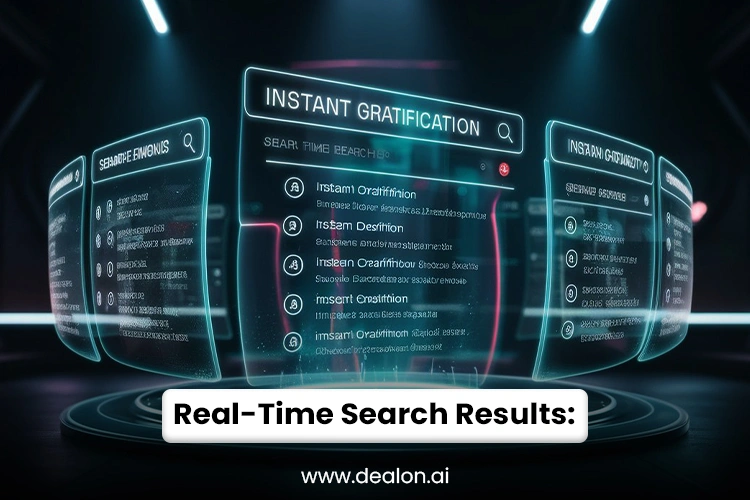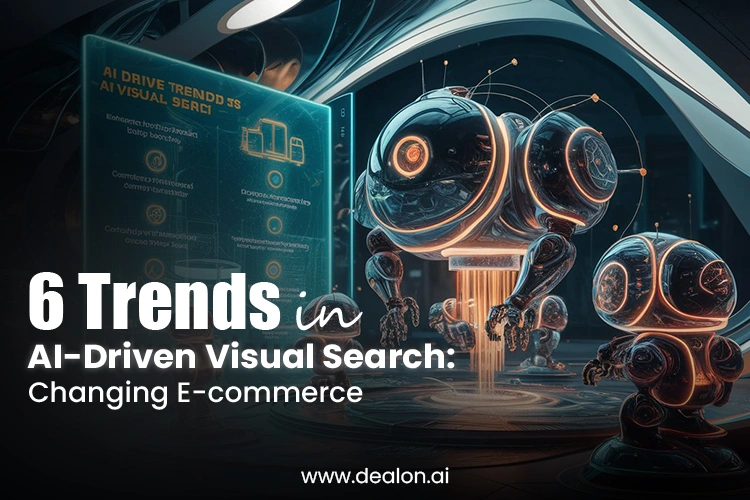In the dynamic realm of e-commerce, AI is revolutionizing the digital shopping experience, mainly through visual search technologies. As consumer expectations continue to escalate, demanding increasingly intuitive and frictionless interactions, AI-powered visual search is emerging as a pivotal force driving transformation in online retail. By enabling users to search for products with nothing more than an image, this technology is not just enhancing convenience—it is reshaping the entire framework of product discovery and customer engagement.
Gone are the days when consumers had to rely solely on keyword searches or lengthy product descriptions. With AI’s ability to analyze and identify products based on visual attributes, shopping has become an immersive, personalized journey that mirrors real-world experiences. As e-commerce brands strive to differentiate themselves in a saturated market, integrating cutting-edge visual search capabilities quickly becomes a competitive advantage. From accelerating search results to fine-tuning personalization, AI-powered visual search unlocks new opportunities for businesses to connect with customers meaningfully. In this blog, we delve into six emerging trends in AI-driven visual search, exploring how they are reshaping the e-commerce landscape and providing innovative solutions to consumers and retailers alike.
Also Read: AI in Content Moderation: Ensuring Brand Safety Across Digital Platforms In 2025
Enhanced Image Recognition Accuracy

AI-powered image recognition has become one of the most significant advancements in e-commerce, revolutionizing how consumers interact with online stores. The ability of AI to identify and analyze images with exceptional precision is transforming the shopping experience, making it faster, more intuitive, and highly personalized. Through advanced algorithms that detect even the most minor details—such as color nuances, texture variations, and shape intricacies—AI can now match images to the exact products in an online catalog with remarkable accuracy.
This innovation is particularly beneficial in e-commerce, where the challenge of product discovery often involves navigating vast inventories filled with similar-looking items. With traditional search methods, consumers may struggle to articulate their preferences using keywords, leading to frustrating results or irrelevant suggestions. However, with enhanced image recognition, consumers can now upload a photo—a snapshot from social media, a picture of a desired item, or even an image taken on the go—and instantly receive relevant, precise product recommendations.
By adopting AI-driven visual search, brands can significantly improve the accuracy of product searches. The technology doesn’t merely rely on generic labels or tags; it considers the visual attributes that genuinely matter to the consumer, delivering results that match the desired style, texture, and design. This precision optimizes the shopping journey and builds trust, as customers feel confident they will find precisely what they are looking for with minimal effort.
Moreover, this enhanced accuracy has a direct impact on e-commerce performance. As users experience more relevant and satisfying search results, bounce rates decrease, and conversion rates soar. With the ability to streamline product discovery and offer an unmatched level of personalization, brands can foster customer loyalty and boost sales, cementing AI-powered image recognition as an indispensable tool in the future of e-commerce.
Visual Search as a Personalized Shopping Assistant

AI-driven visual search is rapidly evolving from a simple tool for recognizing products to becoming a sophisticated, personalized shopping assistant. This transformation is driven by integrating machine learning, deep learning, and user behavior data, which allows visual search systems to tailor product recommendations with remarkable precision. Rather than just identifying items based on their visual characteristics, these systems now analyze a customer’s past interactions, preferences, and emotional responses to suggest products that align closely with the shopper’s style and taste.
In the realm of e-commerce, this leap towards personalization offers significant advantages. Traditional online shopping often relies on keyword-based search, which can be limiting and imprecise. However, visual search powered by AI takes personalization further by suggesting items based on direct queries and nuanced visual preferences. For example, if a consumer uploads a photo of a specific fashion style or home décor piece, the system doesn’t merely return items that look similar; it recommends products that align with the shopper’s previous choices, emerging trends, and even colors or patterns they’ve shown interest in before.
This personalized visual search creates a seamless shopping experience that feels intuitive and individualized. For e-commerce brands, this trend presents an opportunity to enhance customer engagement by offering dynamic recommendations that feel custom-tailored. As consumers are exposed to products that closely match their preferences, they are more likely to convert, fostering stronger customer loyalty and increasing repeat business. The system’s ability to anticipate customer needs also positions brands as proactive and customer-centric, building trust and solidifying long-term relationships.
As AI resumes to refine its knowledge of consumer behavior, the personalized shopping assistant will become even more intelligent, guiding customers effortlessly through their shopping journey. This represents a crucial step forward in e-commerce, as businesses leverage cutting-edge technology to meet the growing demand for unique, personalized experiences.
Real-Time Search Results for Instant Gratification
In today’s fast-paced world, the demand for instant gratification has permeated every aspect of our lives—including online shopping. As consumer expectations rise, the ability to deliver real-time visual search results has become a fundamental requirement in e-commerce. AI-powered algorithms now process visual queries remarkably, providing customers with instantaneous results that mirror the fast, seamless experience they crave. This immediacy not only meets the demands of the modern shopper but also transforms how e-commerce businesses engage with their audiences.
The significance of real-time search results cannot be overstated in the context of e-commerce. Delays in product discovery or slow response times often lead to user frustration, prompting customers to abandon their carts and seek alternatives. With AI-driven visual search, however, customers can instantly upload an image—a picture of a piece of clothing, a home appliance, or even a decorative item—and receive immediate, relevant suggestions from the retailer’s inventory. This speed and efficiency eliminate friction from the shopping experience, keeping customers engaged and reducing the likelihood of cart abandonment.
Furthermore, the rapid processing of search results taps into the psychology of impulse buying, a key driver of e-commerce sales. When shoppers receive near-instantaneous suggestions, the likelihood of making a spontaneous purchase increases, especially when the recommendations are visually compelling and closely aligned with their tastes. This ability to harness AI for swift visual recognition and real-time responses enhances user experience, drives conversions, and accelerates sales.
By adopting real-time visual search technologies, e-commerce brands can tap into a critical advantage: meeting the consumer’s need for speed while optimizing the shopping journey. This technology empowers retailers to create frictionless, efficient, and rewarding shopping experiences that resonate with today’s digitally savvy consumers, ultimately leading to increased satisfaction and higher sales volume.
Cross-Platform Visual Search Integration

In the ever-expanding digital landscape, integrating AI-driven visual search across multiple platforms revolutionizes how consumers shop online. As e-commerce businesses strive to provide a cohesive and seamless omnichannel experience, cross-platform visual search is rapidly emerging as a powerful tool to bridge the gap between social media, mobile apps, and websites. By enabling consumers to transition effortlessly from one shopping environment to another, this technology transforms how people discover, engage with, and ultimately purchase products.
The ability to perform visual searches across various platforms is an innovation that speaks directly to today’s consumer behavior. For instance, imagine a shopper comes across a stunning outfit on Instagram and takes a quick snapshot. Through integrated visual search capabilities, they can instantly upload that image into a brand’s mobile app or website and find the exact product or similar items available for purchase. This functionality empowers consumers to connect their social media discoveries with their purchasing journey and ensures that the transition between browsing and buying is as seamless as possible.
For e-commerce brands, embracing cross-platform visual search integration provides a distinct competitive edge. It permits them to meet customers where they are, whether on a social media platform, a mobile device, or a dedicated website. This fluid connectivity enhances user experience, encourages higher engagement, reduces friction in the purchasing process, and drives increased sales. By creating an interconnected shopping ecosystem, businesses can engage consumers at multiple touchpoints, nurturing them along the path to purchase.
As consumers demand more integrated, omnichannel experiences, the integration of visual search across platforms will continue to evolve. For e-commerce brands, embracing this trend is crucial for remaining competitive and aligning with the changing expectations of today’s consumers, ultimately positioning themselves as leaders in an increasingly competitive marketplace.
Augmented Reality (AR) Integration with Visual Search
The fusion of Augmented Reality (AR) with AI-driven visual search transforms the e-commerce landscape, designing an engaging shopping experience that seamlessly combines the benefits of online and in-store shopping. As AR continues to evolve, its integration with visual search technologies is revolutionizing how consumers make purchasing decisions, providing them unprecedented confidence and satisfaction in their online shopping experiences.
AI-powered visual search enables consumers to easily find products by simply uploading an image, whether a picture of a desired item or a snapshot taken in real life. When combined with AR, this technology takes product discovery to the next level by offering an interactive, real-world simulation of how products will fit into a consumer’s environment. For example, shoppers can visualize how furniture or home décor will look in their living room by simply pointing their phone camera at the space. This immersive capability removes the guesswork from online shopping and enhances decision-making, ensuring consumers feel more confident in their choices before clicking “buy.”
One of the significant edges of AR in e-commerce is its capacity to reduce product returns—a persistent challenge for online retailers. By providing customers with a virtual “try before you buy” experience, AR integration allows them to see products in their actual context, reducing the likelihood of purchasing items that don’t meet expectations. Whether it’s visualizing how a pair of shoes will look in real life or determining if a piece of furniture fits into a particular space, AR minimizes the uncertainty that often accompanies online shopping.
As both AI and AR technologies evolve, their integration in e-commerce will only deepen, offering shoppers an increasingly sophisticated and personalized experience. This synergy is not just shaping the future of online retail—it is redefining how consumers interact with products, creating new opportunities for brands to connect with customers and drive conversions in an increasingly competitive market.
Automated Product Tagging and Inventory Management
AI’s transformative role in e-commerce continues to unfold, with one of the most significant innovations being automated product tagging. Through visual search, AI can automatically assign descriptive tags to new products based on their visual characteristics, such as color, shape, texture, and style. This process not only simplifies the traditionally labor-intensive task of manual categorization but also enhances product discoverability, ultimately improving the overall shopping experience for consumers.
The integration of automated product tagging into e-commerce operations dramatically streamlines inventory management. AI can efficiently analyze product images, categorize items, and assign relevant real-time metadata for businesses with large, frequently changing product catalogs. This decreases the time spent on manual tagging, allowing for faster product updates and ensuring that new items are quickly indexed and ready for customer searches. This immediate categorization supports enhanced operational efficiency, allowing brands to stay ahead in an increasingly fast-paced market.
The implications for e-commerce businesses are profound. Accurate tagging ensures that products are easily discoverable, enhancing the relevance of search results and improving the user experience. Consumers benefit from more precise product suggestions and faster access to the items they seek, increasing the likelihood of conversion. Additionally, the efficiency gained from AI-driven automation empowers businesses to scale quickly without compromising accuracy or product quality, providing a competitive edge in a crowded marketplace.
Moreover, as AI continues to refine its image recognition capabilities, automated tagging will become even more sophisticated, offering more profound insights into product attributes and customer preferences. This evolution will enable brands to maintain dynamic inventories and swiftly adapt to consumer demands, reinforcing the central role of AI in shaping the future of e-commerce.
Conclusion
As e-commerce continues to evolve, AI-driven visual search technologies are at the forefront of this transformation. These innovations fundamentally reshape how consumers interact with online retail, from enhanced image recognition and personalized shopping assistants to real-time search results and cross-platform integration. With the seamless blending of AI and Augmented Reality (AR), shoppers now enjoy immersive experiences that reduce uncertainty and encourage confidence in purchasing decisions, leading to fewer returns and higher satisfaction.
Integrating automated product tagging and inventory management further revolutionizes e-commerce operations. By streamlining cataloging processes, AI increases efficiency and improves product discoverability, creating a smoother and more enjoyable shopping journey for customers. This efficiency empowers businesses to scale and adapt rapidly without compromising accuracy or quality.
As AI technologies advance, their impact on e-commerce will only intensify, creating more intelligent, more intuitive shopping environments that meet the ever-growing demands of today’s digital consumer. For brands, embracing these AI-driven innovations is essential to remaining competitive and delivering exemplary customer experiences in an increasingly crowded and fast-paced market. The future of e-commerce is undoubtedly AI-powered, and those who leverage these trends will be well-positioned to lead the way.

